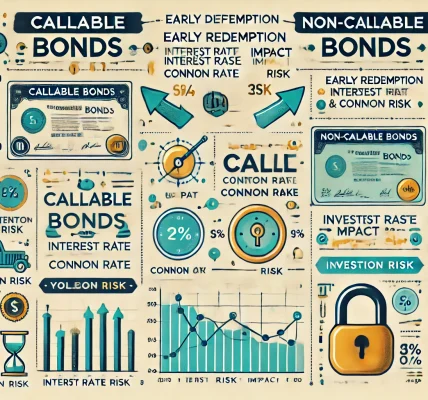Introduction
Inflation is one of the biggest threats to an investor’s wealth. As the cost of goods and services rises over time, the purchasing power of money decreases. This can erode savings and investment returns, particularly for those relying on fixed-income assets. Inflation-linked bonds (ILBs) provide a solution by offering protection against inflation and ensuring that investment returns keep pace with rising prices.
In this guide, we will explore what inflation-linked bonds are, how they work, their benefits and risks, and how investors can use them as part of a diversified portfolio.
What Are Inflation-Linked Bonds?
Inflation-linked bonds are fixed-income securities designed to protect investors from inflation by adjusting their principal and interest payments based on changes in a recognized inflation index. Unlike traditional bonds, where inflation reduces real returns, ILBs ensure that returns maintain their purchasing power.
Key Features of Inflation-Linked Bonds
- Inflation Adjustment: The bond’s principal value is adjusted based on an inflation index (e.g., the Consumer Price Index – CPI).
- Real Interest Payments: Interest (coupon) payments are calculated on the adjusted principal, ensuring income grows with inflation.
- Government-Backed Security: Most ILBs are issued by governments, making them relatively low-risk investments.
- Long-Term Protection: ILBs are ideal for long-term investors looking to hedge against inflation.
How Inflation-Linked Bonds Work
Example:
Let’s say an investor buys an inflation-linked bond with a face value of $1,000 and a 2% coupon rate. If inflation rises by 5% in a year, the bond’s principal adjusts to $1,050. The interest payment is then calculated on this new amount:
- Old Interest Payment: $1,000 × 2% = $20
- New Interest Payment: $1,050 × 2% = $21
This ensures that the investor’s returns increase in line with inflation.
Types of Inflation-Linked Bonds
1. Treasury Inflation-Protected Securities (TIPS) – U.S.
- Issued by the U.S. Treasury
- Principal adjusts based on the Consumer Price Index (CPI)
- Interest payments increase with inflation
- Exempt from state and local taxes
2. Inflation-Linked Gilts – U.K.
- Issued by the UK government
- Principal and interest payments linked to Retail Price Index (RPI)
3. Eurozone Inflation-Linked Bonds
- Issued by European governments
- Adjusted according to the Harmonized Index of Consumer Prices (HICP)
4. Corporate Inflation-Linked Bonds
- Issued by corporations looking to attract investors concerned about inflation
- Offer higher yields than government ILBs but carry more risk
Benefits of Investing in Inflation-Linked Bonds
1. Hedge Against Inflation
- Unlike traditional bonds, ILBs increase in value as inflation rises, ensuring the real value of investments is maintained.
2. Steady Income with Inflation Protection
- Regular interest payments adjust with inflation, providing consistent real income.
3. Government-Backed Security
- Many ILBs are issued by governments, making them low-risk investments with guaranteed principal protection.
4. Diversification for Portfolios
- ILBs help balance an investment portfolio by reducing exposure to inflation-related risks.
5. Capital Preservation
- Investors who prioritize preserving their wealth over high returns benefit from ILBs’ inflation adjustments.
Risks of Investing in Inflation-Linked Bonds
1. Deflation Risk
- If inflation turns negative (deflation), the bond’s principal decreases, leading to lower returns.
2. Lower Yields Compared to Regular Bonds
- ILBs typically offer lower base yields than nominal bonds, making them less attractive in low-inflation environments.
3. Interest Rate Sensitivity
- Like other bonds, ILBs can lose value if interest rates rise significantly.
4. Tax Implications
- The inflation adjustment on the principal may be taxed as income, reducing net returns.
Inflation-Linked Bonds vs. Traditional Bonds
| Feature | Inflation-Linked Bonds | Traditional Bonds |
|---|---|---|
| Protection Against Inflation | Yes | No |
| Fixed Interest Payments | No (adjusts with inflation) | Yes |
| Risk Level | Lower (govt-issued) | Moderate |
| Yield | Lower | Higher |
| Best For | Long-term investors | Income-seeking investors |
How to Invest in Inflation-Linked Bonds
1. Buying Directly from the Government
- Investors can buy TIPS and other ILBs from the government treasury websites or through banks.
2. Investing in ILB ETFs and Mutual Funds
- Exchange-traded funds (ETFs) and mutual funds specializing in ILBs provide diversified exposure to inflation-protected securities.
3. Through a Brokerage Account
- Many brokers offer access to ILBs in the secondary market, where investors can buy and sell bonds before maturity.
4. Incorporating ILBs in Retirement Accounts
- ILBs can be part of IRA, 401(k), or other long-term investment accounts to safeguard against inflation in retirement.
Who Should Invest in Inflation-Linked Bonds?
ILBs are suitable for:
- Retirees & Fixed-Income Investors: Looking for stable, inflation-protected income.
- Conservative Investors: Seeking low-risk investment options.
- Long-Term Investors: Those wanting to maintain purchasing power over time.
- Diversified Portfolio Holders: Investors looking to hedge against inflation while maintaining balance.
Conclusion
Inflation-linked bonds are an essential investment tool for those looking to protect their wealth against rising prices. By ensuring that principal and interest payments adjust with inflation, ILBs provide stability, security, and real returns over time.
While ILBs have lower yields than traditional bonds, their inflation protection makes them valuable in long-term portfolios. Investors should assess their risk tolerance and financial goals to determine the right balance of ILBs in their portfolio.




